Types of lamp bases for lighting lamps: standard markings and types of bases for light bulbs
There are different types of lamp bases.The lack of a uniform standard is due to the size and power of the lighting fixture, the environment in which it operates, the presence of physical impact and many other factors. All types of both cartridges and sockets have established markings, according to which you need to make a purchase.
The content of the article:
Purpose of the lamp base
The lamp base has two purposes:
- Ensuring the operation of the device. The base and socket have contacts, as a result of the connection of which the light source is powered from the mains.
- Possibility of changing the lamp in case of failure or the need to replace it with a device with different parameters. The base-to-cartridge connection should ensure the safety and ease of this operation.
Some types of lighting fixtures do not have a base. They are connected to the electrical circuit using flexible wires.
As a rule, this option is used for low-power lamps that are subject to physical impact or shaking. The “cartridge-base” connection in this case will be a weak point, as a result of which the contact will break.
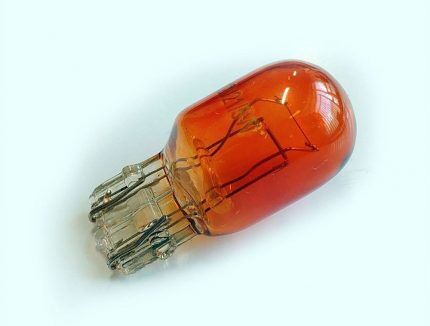
Types of connectors for lighting devices
Many countries have long implemented standards regarding lighting devices. Now, in the period of globalization, you can buy devices from different manufacturers, including foreign ones. Therefore, the number of connection types is very large.
Type “E” – Edison base
The oldest type of connecting a light source to an electrical network is the standard and familiar light bulb base in the form of a screw connection. The number in the marking indicated immediately after the letter “E” indicates the thread diameter in millimeters. There are 10 standard sizes of the Edison base.
Lamps with micro-base “E5” are often installed in foreign household appliances, devices and control panels.
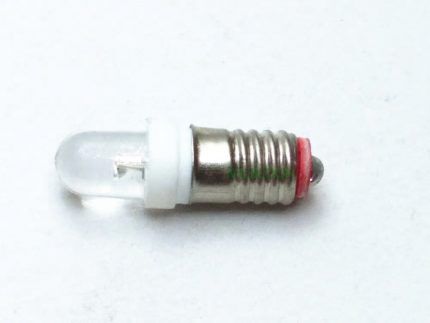
The miniature “E10” base is used for lighting refrigerators, ovens and similar equipment.
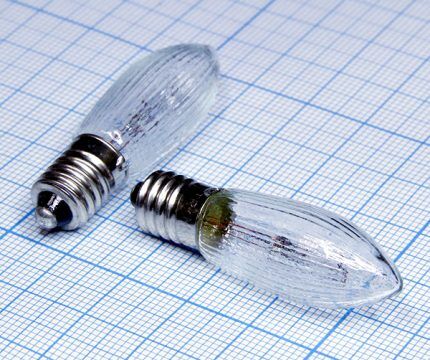
Mini-chandelier sockets “E11” are often used in foreign equipment. For domestic devices, lighting sources with a different connection are used.
The “E12” format is used in interior lighting of household appliances and in imported chandeliers.
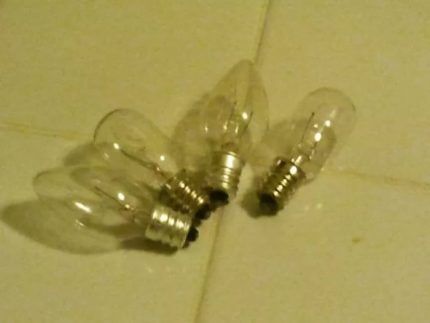
The "E14" format is often called "minion". This is one of the standard socles in the territory of the former USSR.
Many chandeliers, floor lamps, and sconces are equipped with lamps with 14 mm thread sockets.
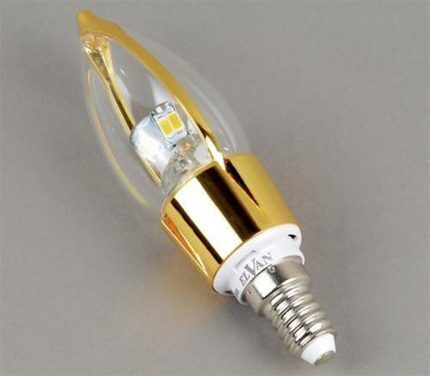
Lighting fixtures in the US and Canada have three screw connection formats. One of them is “E17”.

The second American format is “E26”. It is even more common than the previous one.

“E27” – The most popular format in Russia. You can find light sources for this base in almost any store. Due to its prevalence, most lamps are produced to this standard.

Another North American format, “E39,” is designed for powerful light sources.
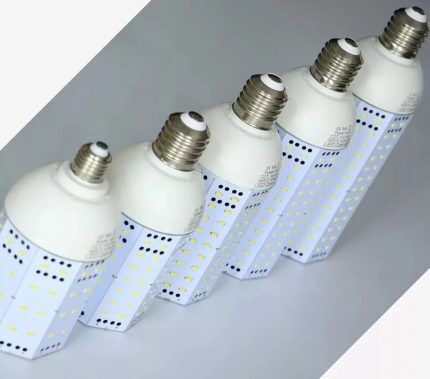
The last format in this list, “E40,” is standard for Russia. Powerful lighting fixtures are made for it, placed, for example, on lamp posts.
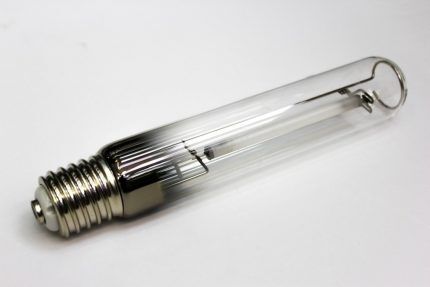
Now the share of lamps with Edison base is decreasing. This is caused by the use of smaller and more economical light sources. However, in Russia the use of threaded connections is still the most popular.
Type "B" - bayonet base
Bayonet (bayonet, pin) connection occurs due to insertion and rotation. It is used in many industries, including electrical engineering. The main area of application is lighting devices that operate under vibration conditions.
This mainly concerns transport. The bayonet connector is standard on electrical systems in the UK and some other countries.
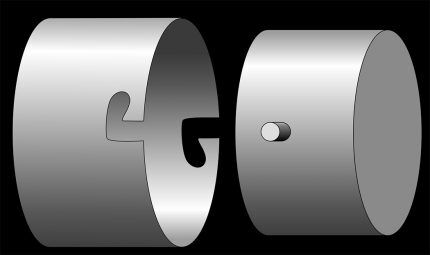
Fasteners with this format are marked with the letter “B”, followed by a number indicating the diameter of the body in millimeters.
Depending on the number of contacts, another letter is added at the end:
- “s” (single) – one contact;
- “d” (double) – two contacts;
- “t” (three) – three contacts;
- “q” (quarto) – four contacts;
- “p” (penta) – five contacts.
A lamp format with three or more contacts is classified as specific industrial equipment. They are not used in everyday life.

The automobile version is marked with the letters “BA”. The main difference is the length of the pin. For an ordinary base this parameter is in the range [0.9; 1.1] mm, and for an automobile the minimum length starts at 0.64 mm.

In addition to the variety associated with the number of contacts, there is another feature that complicates the search for the right type of bayonet base for lighting lamps.
In a standard connection, both pins are located at the same level horizontally and the angle between them is 180°. But if after “B” or “BA” there is also a letter “U”, “X”, “Y” or “Z”, then this means that the pins are offset from their standard position.
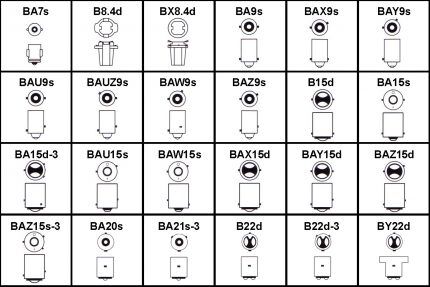
Therefore, when purchasing bayonet lamps (especially for cars), you need to be very careful about each letter of the code that describes the base.
Type "G" - two-pin connector
Another popular type of connecting a lamp to the network through a socket is a two-pin base. It is used in connections of LED and fluorescent lamps. Such a mount is marked with the letter “G” of the Latin alphabet. The numbers that come after it indicate the distance in millimeters between the pins.
Like the bayonet connection, there are modifications to the “G” format. They are designated by adding one of the letters "U", "X", "Y" or "Z" before the numbers. In this case, there will be some differences from the basic format, which can be expressed in the thickness and length of the pins, the presence of grooves and cutouts on the base.
For example, the “GU4” format has thicker pins than the “G4” type, and the “GZ4” type also has longer legs. Therefore, you need to carefully consider the description of the connector, since the modifications are not interchangeable.
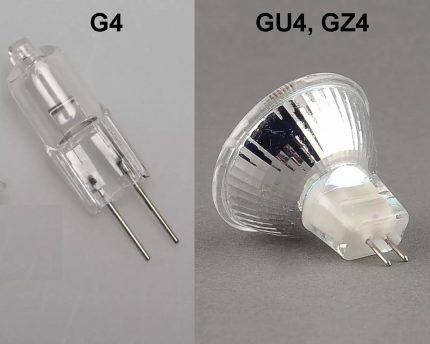
Light sources with mounting types “G5.3”, “GU5.3”, “G6.35”, “GU6.35” and “G8” look and are used similarly.
Starting with the “G9.5” base, the wire-shaped pins are noticeably thicker.
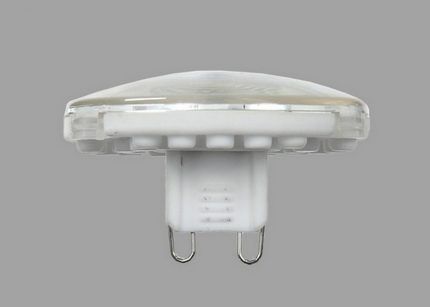
The “G9.5” format has three similar modifications with the letters “X”, “Y” and “Z”. In appearance they are almost identical.
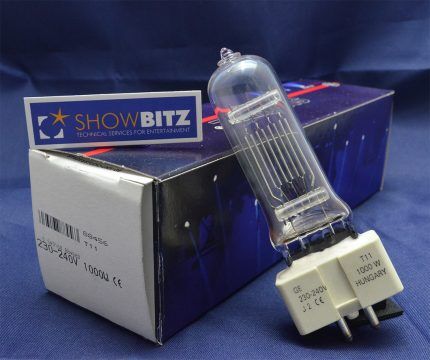
Lighting devices with the “GU10” and “GZ10” connection format are produced mainly in China.
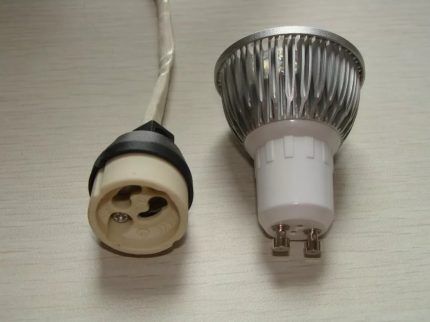
There is no “G11” format, but there is a twin version “2G11”. Also, the sockets “2G7”, “2G23” and “2G27” have 4 contacts each.

The pins at the base “G12” and “G13” have the usual even shape. The 13th format uses tubular LED lamps.
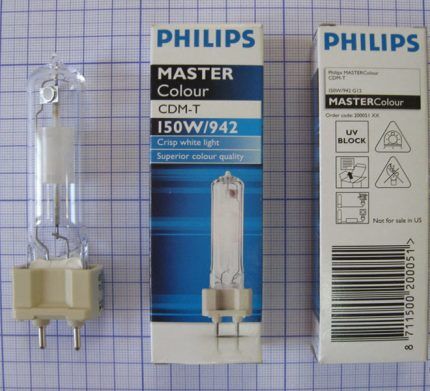
The next two-pin connector in order is “G23”. It has an original look, quite different from smaller devices.
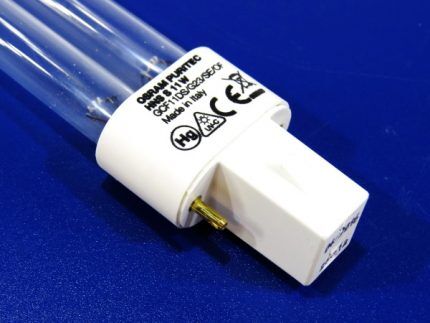
The “G24” socket is used for compact fluorescent lamps, the tube of which is folded in four.
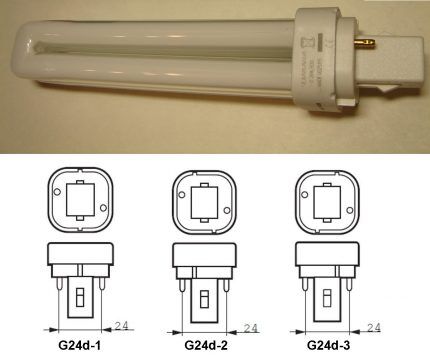
There are very rare lamps for "G36" and "G38" sockets for use in narrow areas.Thus, the Sylvania FKK CP73/CP41 halogen type model with a “G38” base is used for photo optics.

The given list of two-pin connection formats shows how diverse there are bases for light bulbs of seemingly the same type. Therefore, if the markings of the cartridge are not known, then you need to carefully measure its parameters or bring it to the store.
Type “F” – single-pin connector
On some types of tubular halogen and fluorescent lamps, single-pin sockets are sometimes used, which are located at both ends of the lighting device. This solution allows you to simultaneously pass electric current and securely fix the lamp. This type of mount is marked with the letter “F”.
There are 3 modifications depending on the shape of the pin:
- “a” – cylindrical;
- “b” – corrugated;
- “c” – special.
The number that closes the code name of the base indicates the diameter of the pin in millimeters.
The “Fa4” type socket has been used for halogen lamps since the times of the USSR. Finding lighting devices and cartridges for this format is easy.

The “Fa6” type connector is used by foreign manufacturers to equip fluorescent lamps. They are used where, according to fire regulations, the occurrence of an open fire is unacceptable.
This can be not only large-scale, but also small-scale production. Wood or flour suspension can cause an explosion, so such a lighting source is relevant for a carpentry or flour mill.
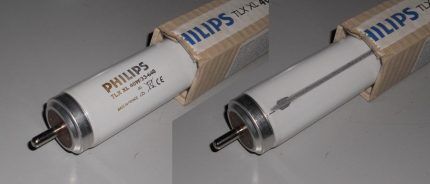
For household purposes, you can also use lamps with the “Fc2” format.
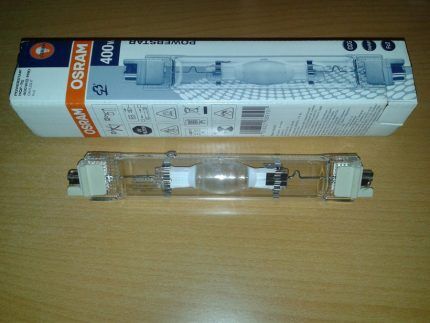
Bases with grooved pins are now out of use.
Type “R” – with recessed contact
This type is very similar to the "F" format, however the lamp contacts are recessed inside the pin. The socket for such a base contains two spring-loaded metal protrusions that fix the lamp and provide electrical commutation.
There are only two types of such sockets: “R7s” and “Rx7s”. The pin diameter for both options is 7 mm. The main difference is in the mounting geometry.
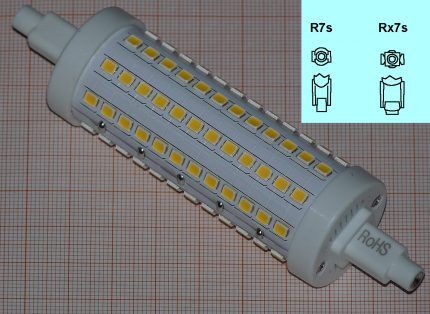
There is also a modification “Rx7s-24”. The difference from the “Rx7s” is only in the length of the lamp - 132 mm versus 120 mm. Those. the base part is identical, but the length of the cartridge for the Rx72-24 will be longer.
Type “S” – soffit base
The soffit type got its name because of the typical area of application of the lamps - lighting of bathrooms and stages, illumination of mirrors. It can be located on both sides for tubular type lamps or as a single base.
This type of fastening is designated by the letter “S”. The number following it shows the diameter of the base housing.
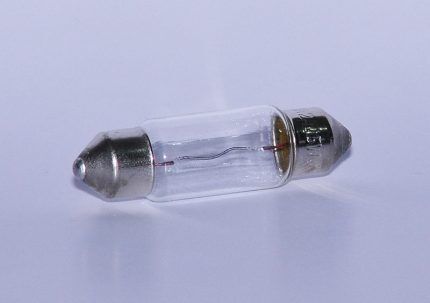
For tubular lamps, the “S14” connector format is often used, for which there are two varieties. Models “S14s” have two contacts on the sides, and “S14d” have one paired one in the middle. The shape of the plinth body differs from the usual one.

The “S19s” base shape is classic for soffit connectors.
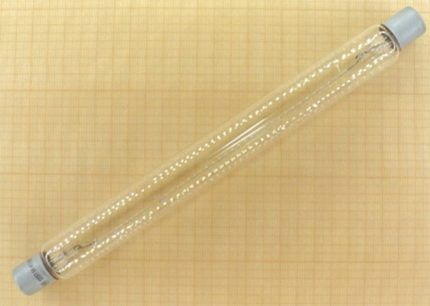
Lamps with a soffit base housing diameter exceeding 19 mm are not produced.
Type “K” – with wired connection
Instead of the standard socket-socket combination, a cable connection is sometimes used, which is called a "wired socket". It is marked with the letter “K”.

Such lamps are used to illuminate large objects. Since the conditions for installing floodlights are different everywhere, the best option for connecting such devices is to use a wire base.
Type “H” – for xenon lamps
There are many different light sources installed in a car. For precise placement of light bulbs, special sockets marked “H” are used. This is necessary primarily for focusing the headlights. The number following the letter indicates the subtype of this format.

The conductive plates are designed in such a way as to fix the light bulb in a certain position, taking into account the vibrations and shaking that occur when the car moves.
Type "P" - flanged bases
The flange type of base is used when it is necessary to clearly focus the light source, which is why it is often called “focusing”. Lamps with this type of mounting are used mainly in the automotive industry.
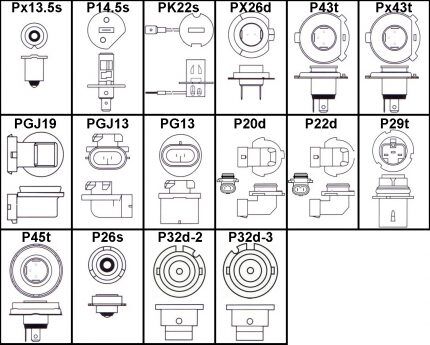
It should be noted that the shapes of “P” type socles are varied and do not have any common geometric features.
Their separation into a separate type occurs only because of the ability to clearly establish the light source relative to the reflector or lenses.
Type “T” – telephone format
The telephone socket is used for small light bulbs that are installed in switchboards, control panels and cars. Light sources with this connection format are designated by the letter “T”, followed by a number indicating the mounting diameter in millimeters.

The "T6.5" format has a similar appearance. But lamps with a “T5” socket, which are used in a car’s dashboard, look different.
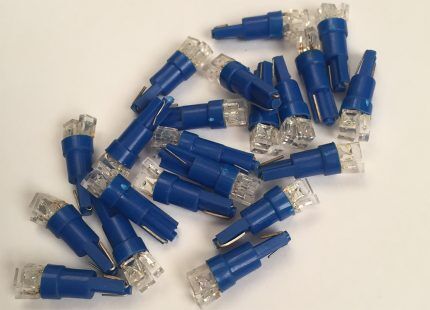
Two more formats that are often used for vehicles: “T10” and “T20”.
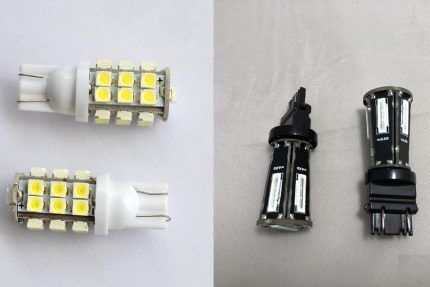
Since LED bulbs heat up, the bases are made of heat-resistant plastic. It must withstand temperatures above 130°C.
Using Base Adapters
Sometimes situations arise when it is not possible to find a lamp with the required parameters for a specific format. For example, after purchasing a three-arm chandelier with “E14” sockets, installing it and connecting the lamps, it turns out that there is not enough light from it, even when using powerful LED sources such as Lightstar T35, which produce 950 lm.
In order not to change the chandelier, you can use special adapters from one standard size “E” base to another. By using the “E14 –> E27” adapter, you can connect “E27” format lamps, which can produce a more significant luminous flux. For example, the X-flash 50 model shines with a brightness of 1650 lm.
Also on sale are adapters from one type of base to another. The most popular types are “E –> G” and vice versa. All these devices can be purchased in stores or ordered on well-known online platforms.
Conclusions and useful video on the topic
Types of lamps for conventional screw sockets:
You must buy a lamp in strict accordance with the socket markings. In simple cases, especially for the “E” format, you can do this yourself. But for other types there are many modifications and nuances. If in doubt, it is better to contact a consultant in a specialized department.
If, while reading the article, you have questions or have information that complements the information presented, please write comments in the block located below the text.





Previously, we used lamps with an E27 base, but they flew in our chandeliers very often. Now we have switched to energy-saving ones.
By the way, this is the first time I ever heard that there are adapters for lamps.
Unfortunately, sometimes there are situations when the standard marking of caps begins to “slip”. In particular, this applies to the Edison pinout, which in some countries is being redesigned in its own way. So in the States (and in some places in Canada) our standard E27 base is usually labeled as ES, and the reduced E14 as SES. These are abbreviations for the expressions Edison Screw and Small Edison Screw. There are the same ones for other “E-sheks”.
I have also come across Asian light bulbs, the markings of which are based not on the type of base, but on the outer diameter of the bulb, for example, T1 corresponds to 3 mm, T1½ - 4.5 mm, T2 - 6 mm, etc. Moreover, these are not T bases, but classic light bulbs with a screw base.
Standardization is everything! At home - only E 27, all lamps without exception, so as not to keep a supply of different ones in case of failure.